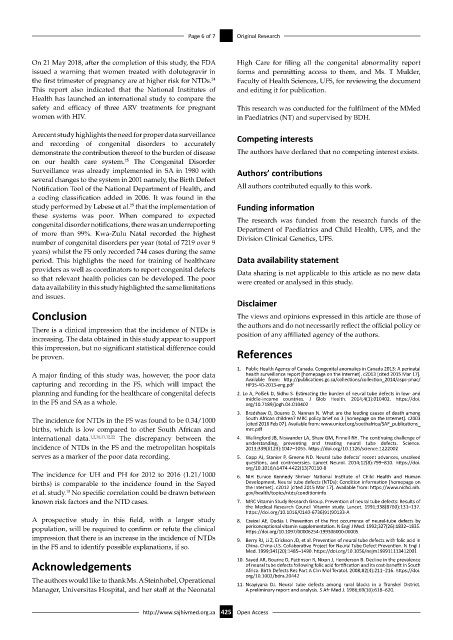Page 433 - HIVMED_v21_i1.indb
P. 433
Page 6 of 7 Original Research
On 21 May 2018, after the completion of this study, the FDA High Care for filing all the congenital abnormality report
issued a warning that women treated with dolutegravir in forms and permitting access to them, and Ms. T Mulder,
24
the first trimester of pregnancy are at higher risk for NTDs. Faculty of Health Sciences, UFS, for reviewing the document
This report also indicated that the National Institutes of and editing it for publication.
Health has launched an international study to compare the
safety and efficacy of three ARV treatments for pregnant This research was conducted for the fulfilment of the MMed
women with HIV. in Paediatrics (NT) and supervised by BDH.
A recent study highlights the need for proper data surveillance Competing interests
and recording of congenital disorders to accurately
demonstrate the contribution thereof to the burden of disease The authors have declared that no competing interest exists.
on our health care system. The Congenital Disorder
25
Surveillance was already implemented in SA in 1980 with Authors’ contributions
several changes to the system in 2001 namely, the Birth Defect
Notification Tool of the National Department of Health, and All authors contributed equally to this work.
a coding classification added in 2006. It was found in the
25
study performed by Lebese et al. that the implementation of Funding information
these systems was poor. When compared to expected The research was funded from the research funds of the
congenital disorder notifications, there was an underreporting
of more than 99%. Kwa-Zulu Natal recorded the highest Department of Paediatrics and Child Health, UFS, and the
number of congenital disorders per year (total of 7219 over 9 Division Clinical Genetics, UFS.
years) whilst the FS only recorded 744 cases during the same
period. This highlights the need for training of healthcare Data availability statement
providers as well as coordinators to report congenital defects Data sharing is not applicable to this article as no new data
so that relevant health policies can be developed. The poor were created or analysed in this study.
data availability in this study highlighted the same limitations
and issues.
Disclaimer
Conclusion The views and opinions expressed in this article are those of
the authors and do not necessarily reflect the official policy or
There is a clinical impression that the incidence of NTDs is position of any affiliated agency of the authors.
increasing. The data obtained in this study appear to support
this impression, but no significant statistical difference could
be proven. References
1. Public Health Agency of Canada. Congenital anomalies in Canada 2013: A perinatal
A major finding of this study was, however, the poor data health surveillance report [homepage on the Internet]. c2013 [cited 2015 Mar 17].
Available from: http://publications.gc.ca/collections/collection_2014/ aspc-phac/
capturing and recording in the FS, which will impact the HP35-40-2013-eng.pdf
planning and funding for the healthcare of congenital defects 2. Lo A, Polšek D, Sidhu S. Estimating the burden of neural tube defects in low- and
in the FS and SA as a whole. middle-income countries. J Glob Health. 2014;4(1):010402. https://doi.
org/10.7189/jogh.04.010402
3. Bradshaw D, Bourne D, Nannan N. What are the leading causes of death among
The incidence for NTDs in the FS was found to be 0.34/1000 South African children? MRC policy brief no 3 [homepage on the Internet]. c2003
[cited 2016 Feb 07]. Available from: www.unicef.org/southafrica/SAF_publications_
births, which is low compared to other South African and mrc.pdf
international data. 1,2,10,11,12,22 The discrepancy between the 4. Wallingford JB, Niswander LA, Shaw GM, Finnell RH. The continuing challenge of
incidence of NTDs in the FS and the metropolitan hospitals understanding, preventing and treating neural tube defects. Science.
2013;339(6123):1047–1055. https://doi.org/10.1126/science.1222002
serves as a marker of the poor data recording. 5. Copp AJ, Stanier P, Greene ND. Neural tube defects’ recent advances, unsolved
questions, and controversies. Lancet Neurol. 2014;12(8):799–810. https://doi.
org/10.1016/s1474-4422(13)70110-8
The incidence for UH and PH for 2012 to 2016 (1.21/1000 6. NIH Eunice Kennedy Shriver National Institute of Child Health and Human
births) is comparable to the incidence found in the Sayed Development. Neural tube defects (NTDs): Condition information [homepage on
the Internet]. c2012 [cited 2015 Mar 17]. Available from: https://www.nichd.nih.
et al. study. No specific correlation could be drawn between gov/health/topics/ntds/conditioninfo
10
known risk factors and the NTD cases. 7. MRC Vitamin Study Research Group. Prevention of neural tube defects: Results of
the Medical Research Council Vitamin study. Lancet. 1991;338(8760):131–137.
https://doi.org/10.1016/0140-6736(91)90133-A
A prospective study in this field, with a larger study 8. Czeizel AE, Dudás I. Prevention of the first occurrence of neural-tube defects by
population, will be required to confirm or refute the clinical periconceptional vitamin supplementation. N Engl J Med. 1992;327(26):1832–1835.
https://doi.org/10.1097/00006254-199306000-00005
impression that there is an increase in the incidence of NTDs 9. Berry RJ, Li Z, Erickson JD, et al. Prevention of neural tube defects with folic acid in
in the FS and to identify possible explanations, if so. China. China-U.S. Collaborative Project for Neural Tube Defect Prevention. N Engl J
Med. 1999;341(20):1485–1490. https://doi.org/10.1056/nejm199911113412001
Acknowledgements 10. Sayed AR, Bourne D, Pattinson R, Nixon J, Henderson B. Decline in the prevalence
of neural tube defects following folic acid fortification and its cost-benefit in South
Africa. Birth Defects Res Part A Clin Mol Teratol. 2008;82(4):211–216. https://doi.
org/10.1002/bdra.20442
The authors would like to thank Ms. A Steinhobel, Operational 11. Ncayiyana DJ. Neural tube defects among rural blacks in a Transkei District.
Manager, Universitas Hospital, and her staff at the Neonatal A preliminary report and analysis. S Afr Med J. 1986;69(10):618–620.
http://www.sajhivmed.org.za 425 Open Access

